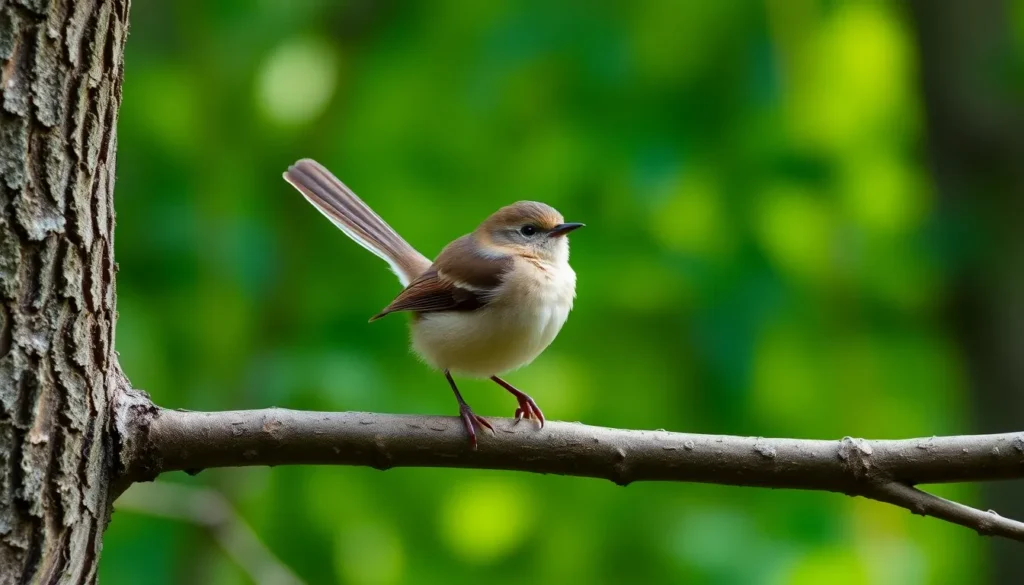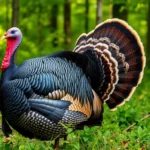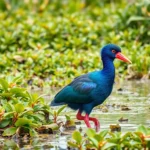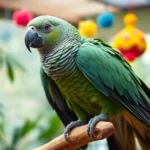We’ve all heard that distinctive “fee-bee” call echoing through woodlands and parks but many of us don’t realize we’re listening to one of North America’s most charming flycatchers. The phoebe bird with its gentle demeanor and remarkable adaptability has captured the hearts of birdwatchers and nature enthusiasts for generations.
These small gray-brown birds aren’t just pretty faces in the avian industry – they’re fascinating creatures with unique behaviors that’ll surprise you. From their incredible tail-wagging habits to their impressive nest-building skills phoebes demonstrate remarkable intelligence and resilience that makes them stand out among songbirds.
Whether you’re a seasoned birder or just starting to notice the wildlife around you understanding phoebe birds opens up a whole new industry of backyard discovery. We’ll explore everything you need to know about these delightful creatures and why they deserve a special place in your heart.
What Is a Phoebe Bird?
The phoebe bird belongs to the tyrant flycatcher family Tyrannidae, representing one of North America’s most recognizable songbird species. These small passerines measure 6.5 to 7 inches in length with wingspans reaching 10 to 11 inches. Phoebe birds display distinctive olive-brown to grayish-brown plumage on their upperparts, while their underparts range from white to pale yellow depending on the species.
Three primary phoebe species inhabit North America: the Eastern Phoebe (Sayornis phoebe), Black Phoebe (Sayornis nigricans), and Say’s Phoebe (Sayornis saya). Each species occupies distinct geographical ranges and habitats across the continent. Eastern Phoebes frequent woodlands and suburban areas throughout eastern North America, while Black Phoebes prefer areas near water sources in western regions.
Taxonomically, phoebes constitute the genus Sayornis within the family Tyrannidae. Scientists classify these birds as insectivorous flycatchers that exhibit specialized hunting behaviors and territorial patterns. Their scientific classification places them among approximately 400 flycatcher species worldwide, though phoebes remain uniquely North American in their distribution.
Phoebes demonstrate remarkable adaptability in habitat selection, thriving in mixed forests, parks, suburban gardens, and streamside environments. They construct cup-shaped nests using mud, moss, and plant fibers, often positioning these structures under bridges, building eaves, or rocky overhangs. Female phoebes typically lay 3 to 5 white eggs per clutch, with breeding seasons extending from March through August depending on geographic location.
Their diet consists primarily of flying insects including flies, beetles, moths, and wasps, which they catch through aerial hunting techniques called “hawking.” Phoebes also consume berries and small fruits during autumn and winter months when insect availability decreases. These feeding behaviors make them valuable allies for gardeners and property owners seeking natural pest control answers.
Physical Characteristics of Phoebe Birds
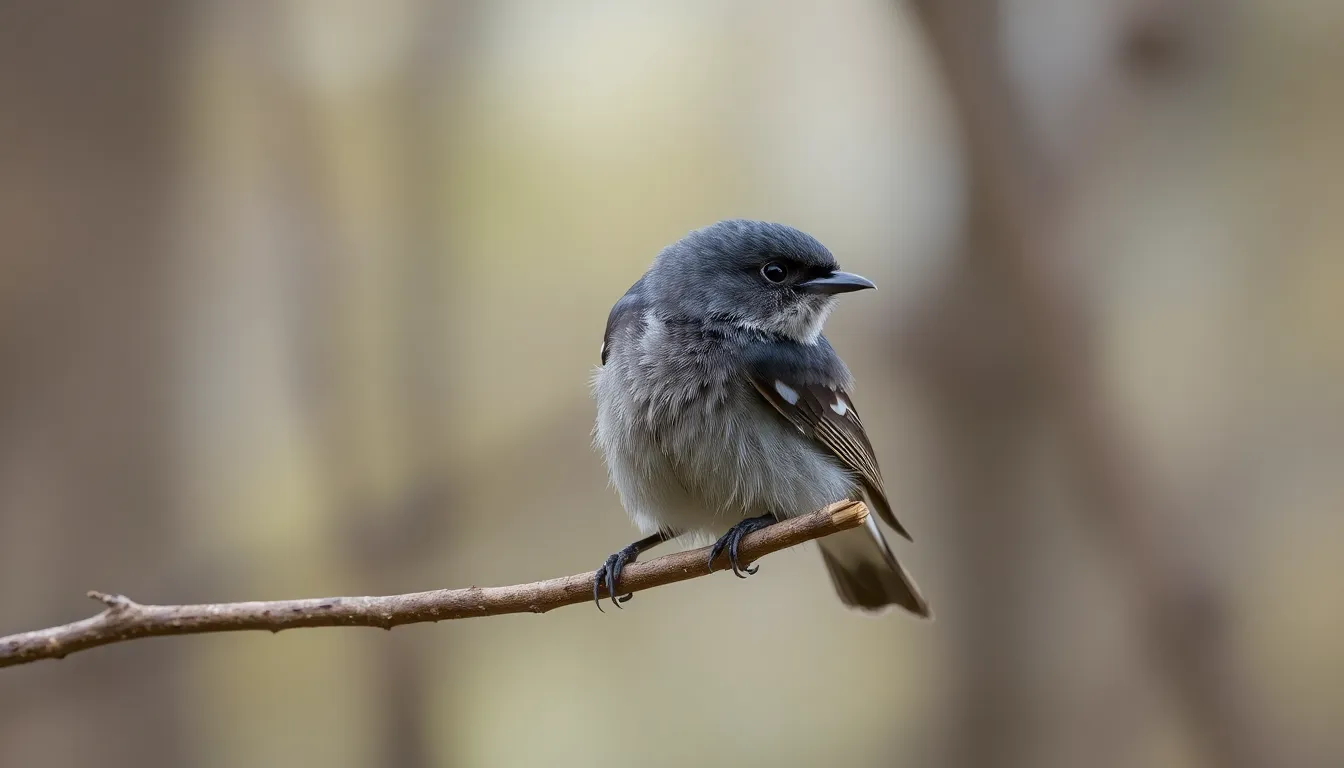
Phoebe birds display consistent physical traits across their three North American species that make identification straightforward for birdwatchers. We observe these medium-sized flycatchers maintaining subtle yet distinctive appearances that complement their woodland and suburban habitats.
Size and Build
Phoebe birds measure between 5.5 to 7 inches in length with wingspans ranging from 10 to 11 inches. Eastern Phoebes weigh approximately 0.6 to 0.7 ounces while Black Phoebes and Say’s Phoebes reach slightly larger weights of 0.5 to 0.8 ounces. We notice their compact yet sturdy build features proportionally large heads and broad shoulders that support their aerial hunting lifestyle.
Their bodies exhibit the classic flycatcher silhouette with straight backs and upright postures when perched. Legs appear relatively short but strong, allowing secure grips on branches and fence posts. Wings extend to cover roughly two-thirds of their tail length when folded, creating a streamlined profile during flight.
Coloring and Markings
Eastern Phoebes showcase olive-brown to grayish-brown upperparts with lighter whitish or pale yellow underparts. We observe their heads appearing darker than their backs, often displaying a subtle cap effect. Wings and tail feathers contain slightly darker brown tones with minimal white markings on wing bars.
Black Phoebes present striking black heads, backs, wings, and upper breast areas contrasting sharply with bright white bellies and undertail coverts. Their wings show faint white edging on flight feathers that becomes visible during extended flight sequences. Say’s Phoebes feature warm grayish-brown upperparts with distinctive peachy or salmon-colored lower bellies and undertail coverts.
| Species | Head Color | Back Color | Belly Color | Distinctive Markings |
|---|---|---|---|---|
| Eastern Phoebe | Dark grayish-brown | Olive-brown | Whitish-yellow | Faint wing bars |
| Black Phoebe | Jet black | Black | White | White wing edging |
| Say’s Phoebe | Grayish-brown | Grayish-brown | Peachy-salmon | Rusty undertail |
Distinctive Features
Phoebe birds possess several identifying characteristics that distinguish them from other flycatcher species. We recognize their prominent dark eyes surrounded by thin white eye rings that create subtle facial contrast. Bills appear broad and slightly flattened with dark coloration and small hook tips designed for capturing insects mid-flight.
Their most recognizable behavior involves constant tail wagging or pumping motions while perched, creating a rhythmic up and down movement. Posture remains upright with heads held high, allowing optimal visibility for spotting aerial prey. We observe their preference for exposed perching locations such as fence posts, dead branches, and building eaves.
Flight patterns display typical flycatcher characteristics with quick bursts followed by gliding movements. Their wing beats appear shallow and rapid during hunting sorties, enabling precise maneuvering around obstacles while pursuing insects. Calls consist of distinctive “fee-bee” or “phoebe” vocalizations that carry clearly across their territories.
Common Phoebe Bird Species
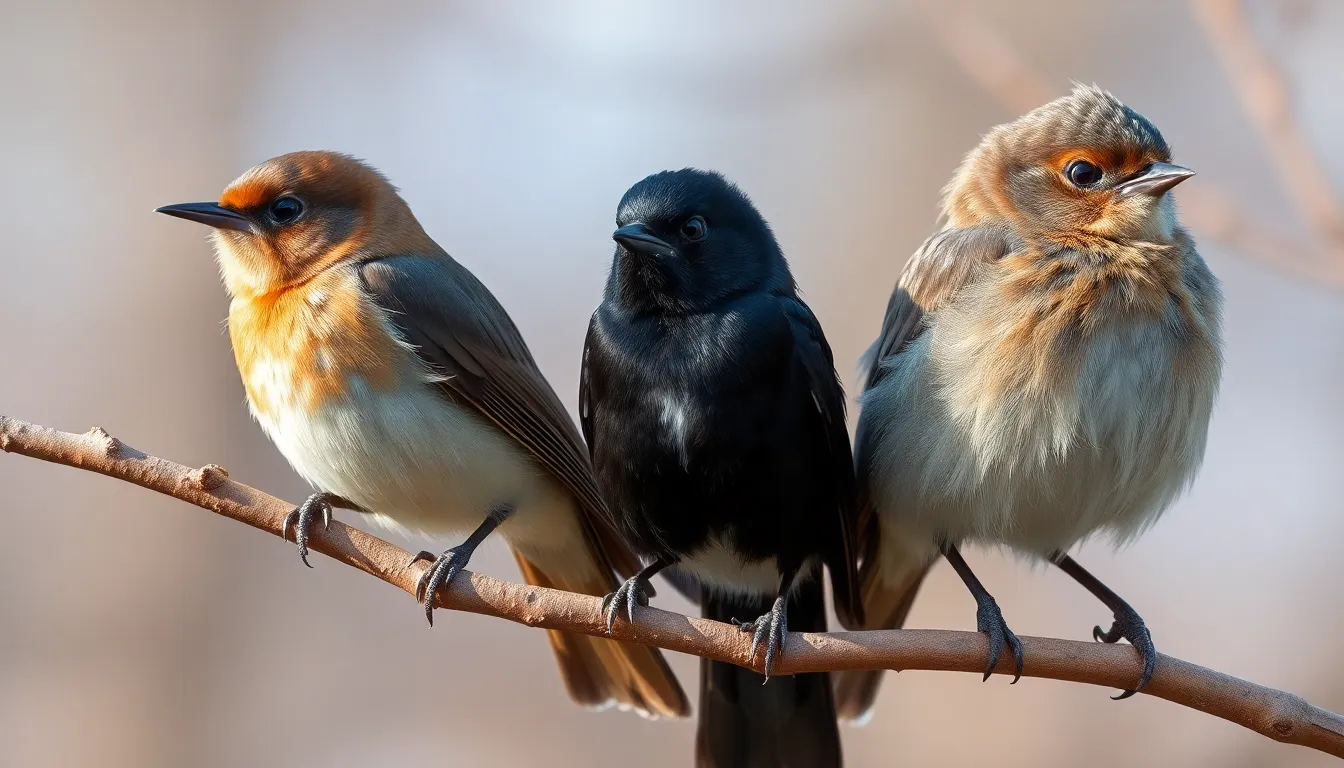
We find three distinct phoebe species across North America, each adapted to exact habitats and displaying unique characteristics. These flycatchers occupy different geographical regions while maintaining similar behavioral patterns.
Eastern Phoebe
Eastern Phoebes (Sayornis phoebe) represent the most widely distributed species across eastern North America. We observe these birds from southeastern Canada down to the Gulf Coast, extending west to the Great Plains during breeding season. Their olive brown upperparts contrast with pale yellow underparts, creating subtle yet distinctive coloring that helps with identification.
These adaptable birds select diverse nesting sites including bridge structures, building eaves, and cliff faces near water sources. We document their preference for areas with mixed woodlands adjacent to open spaces where insect prey remains abundant. Eastern Phoebes arrive at breeding grounds in March and remain through October in northern regions.
Their characteristic “fee bee” call echoes through wooded areas during spring courtship, with males repeating this vocalization up to 3,000 times per day. We notice their tendency to return to the same nesting territories annually, demonstrating strong site fidelity across generations.
Black Phoebe
Black Phoebes (Sayornis nigricans) inhabit western regions from Oregon south through Central America. We identify these striking birds by their jet black heads, backs, and wings paired with bright white bellies and outer tail feathers. Their contrasting plumage makes them among the most recognizable flycatcher species.
These birds show strong associations with water sources, building nests on structures near streams, ponds, and coastal areas. We find Black Phoebes in elevations ranging from sea level to 7,000 feet, adapting to various climatic conditions throughout their range. Their mud cup nests attach to vertical surfaces including rock walls, buildings, and bridge supports.
Black Phoebes maintain year round residency in most of their range, with some northern populations moving to lower elevations during winter months. We observe their hunting behavior from prominent perches, making quick flights to capture insects before returning to the same spot.
Say’s Phoebe
Say’s Phoebes (Sayornis saya) occupy the western interior regions from central Canada to Mexico. We distinguish these birds by their grayish brown upperparts and distinctive peachy cinnamon lower bellies and undertail coverts. Their pale throat and breast create a subtle gradation between the darker back and warmer belly tones.
These hardy birds thrive in open country including sagebrush flats, ranch lands, and desert areas with scattered vegetation. We find Say’s Phoebes at elevations up to 10,000 feet, making them the highest altitude phoebe species. Their nesting sites include cliff ledges, abandoned buildings, and even ground locations under overhanging rocks.
Say’s Phoebes demonstrate the longest migration distances among phoebe species, with northern populations traveling to southern Mexico for winter. We track their arrival at breeding grounds from March through May, depending on latitude and local weather conditions. Their call differs from other phoebes, producing a distinctive “pit see” or “phee eur” vocalization.
Habitat and Distribution
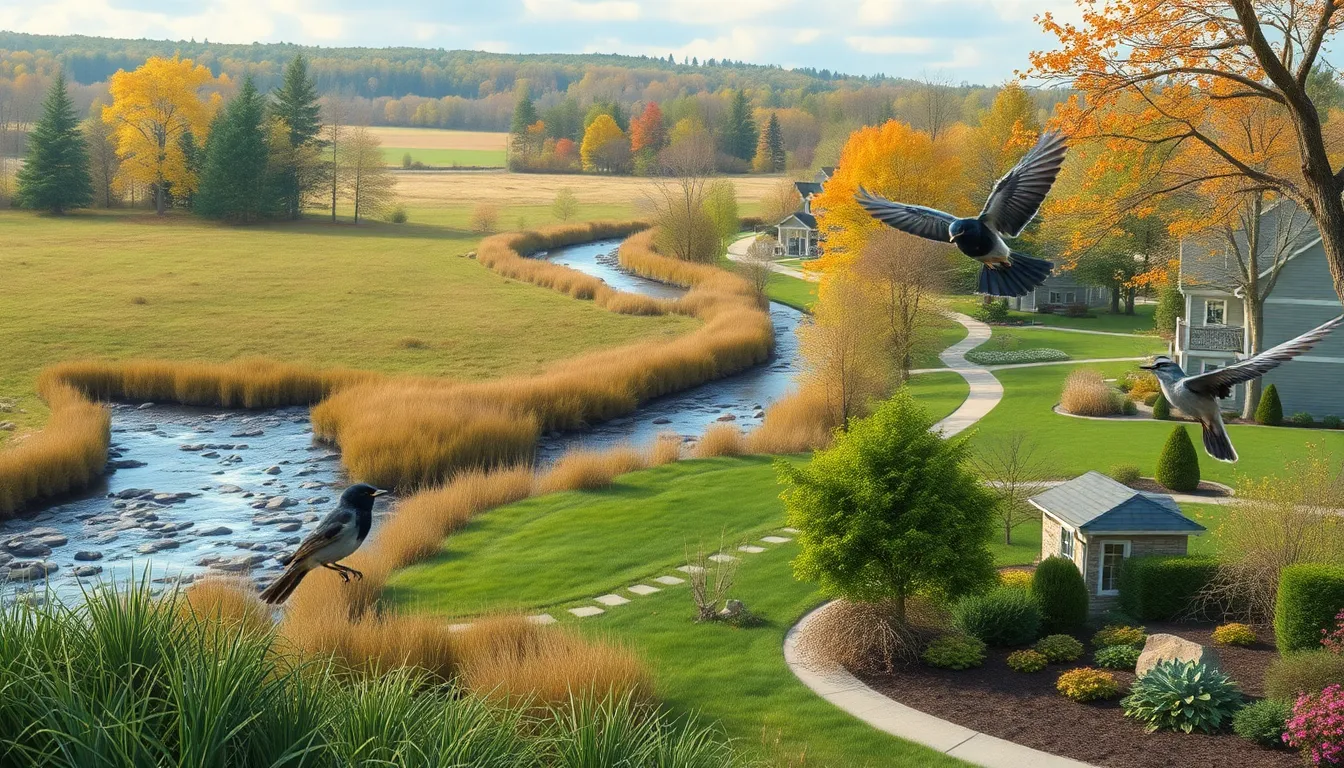
Phoebe birds demonstrate remarkable adaptability in their habitat selection and maintain distinct distribution patterns across North America. Each species occupies exact geographic regions while showing preferences for particular environmental conditions.
Preferred Environments
Phoebe species thrive in diverse ecosystems that provide adequate hunting opportunities and nesting sites. Eastern Phoebes favor mixed deciduous forests, woodland edges, and areas near water sources such as streams, ponds, and rivers. These birds commonly inhabit parks, suburban gardens, and farmlands where they can access both natural and human-made structures for nesting.
Black Phoebes show a strong preference for environments near water bodies, including coastal areas, lakeshores, stream banks, and irrigation ditches. Open woodlands, parks with water features, and urban areas with fountains or ponds attract these birds consistently. Their habitat selection centers around permanent water sources that support abundant insect populations.
Say’s Phoebes prefer open country habitats including grasslands, sagebrush flats, agricultural areas, and desert regions. These birds adapt well to ranch lands, golf courses, and suburban areas with sparse tree cover. Mountain meadows and canyon areas up to 9,000 feet elevation provide suitable breeding grounds for this species.
Geographic Range
Eastern Phoebe populations span the largest distribution range among the three species, extending from southeastern Canada through the eastern United States to the Gulf Coast states. During breeding season, these birds occupy territories from Nova Scotia west to Alberta and south to Texas and Florida. Winter migrations take Eastern Phoebes to southeastern states, Mexico, and Central America.
Black Phoebe range covers western North America from British Columbia south to Argentina. Year-round residents exist along the Pacific Coast from Oregon to Baja California, while breeding populations extend inland through California, Nevada, Arizona, and New Mexico. These birds remain non-migratory in most coastal areas but move to lower elevations during winter months.
Say’s Phoebe distribution encompasses western North America from Alaska to central Mexico. Breeding territories stretch from western Canada through the western United States, including Montana, Wyoming, Colorado, and New Mexico. Migration patterns take these birds to wintering grounds in southwestern United States and Mexico, with some populations traveling distances exceeding 2,000 miles between breeding and wintering areas.
Behavior and Lifestyle
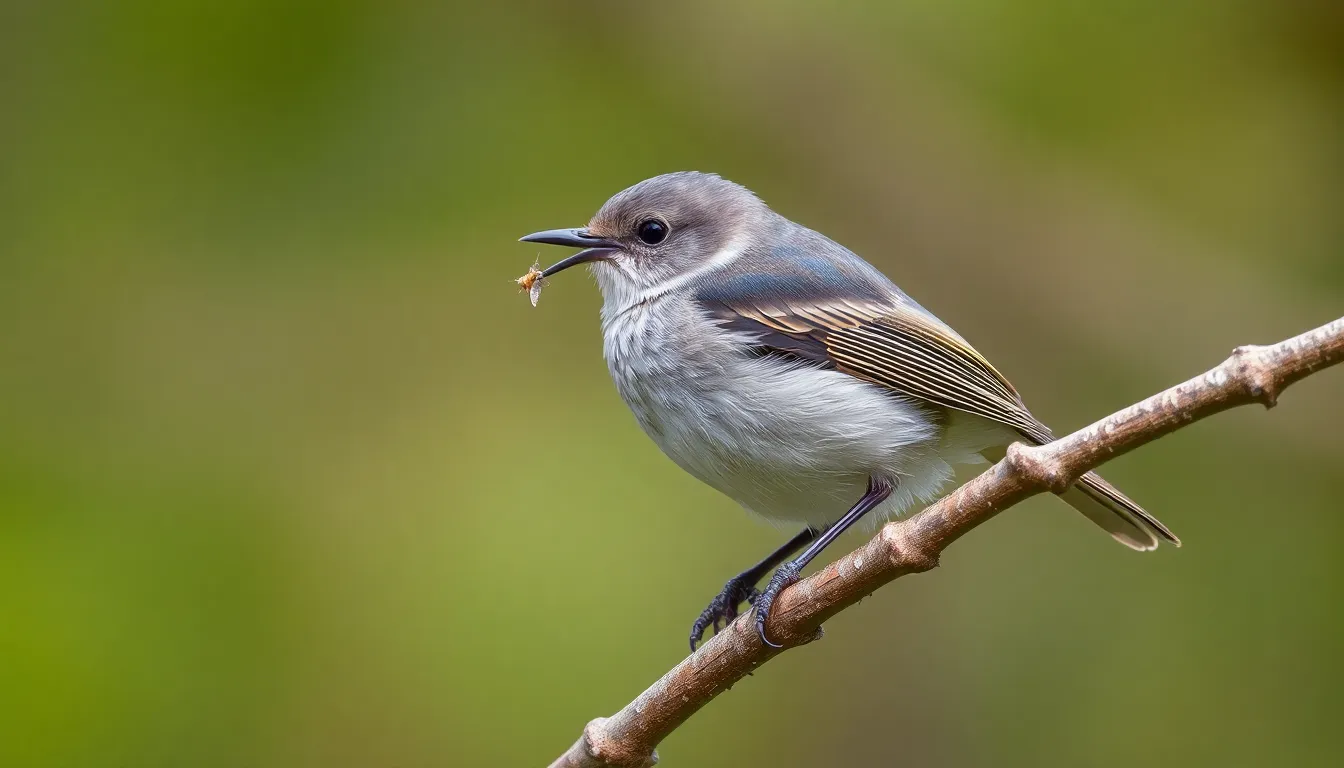
Phoebe birds exhibit fascinating behavioral patterns that reflect their adaptability and survival instincts across diverse environments. Their daily activities revolve around efficient hunting strategies, strategic nesting choices, and remarkable seasonal movements.
Feeding Habits
Phoebes demonstrate exceptional aerial hunting skills by catching insects mid-flight from strategic perches. These flycatchers consume approximately 85% flying insects including flies, beetles, moths, and mosquitoes during peak feeding hours between dawn and dusk. We observe phoebes using the “sally and return” hunting technique where they dart from perches to capture prey before returning to the same spot.
Eastern Phoebes supplement their diet with berries and small fruits during autumn months when insect availability decreases by 40%. Black Phoebes focus primarily on aquatic insects like midges and mayflies due to their proximity to water sources. Say’s Phoebes adapt their diet seasonally, consuming ground insects during winter months when aerial prey becomes scarce in open habitats.
Adult phoebes feed their nestlings every 6-8 minutes during daylight hours, delivering an average of 350-400 insects per day to support rapid chick development.
Nesting Patterns
Phoebe birds construct their cup-shaped nests using mud, moss, and plant fibers in locations that provide optimal protection from predators and weather. Eastern Phoebes frequently build nests under bridges, eaves, and rocky overhangs at heights ranging from 3-15 feet above ground. We find that these birds show remarkable site fidelity, returning to successful nesting locations for multiple breeding seasons.
Black Phoebes prefer nesting sites within 100 meters of water sources, often choosing cliff faces, culverts, and man-made structures near streams or ponds. Female phoebes take 5-7 days to complete nest construction while males defend territories spanning 2-5 acres around the nesting site.
Say’s Phoebes demonstrate flexibility in nest placement by utilizing abandoned buildings, rock crevices, and even old bird nests in open country environments. Breeding pairs typically produce 2-3 broods per season with clutch sizes averaging 4-5 eggs that incubate for 14-16 days.
Migration Behavior
Eastern Phoebes undertake partial migrations with northern populations traveling 800-2,000 miles to wintering grounds along the Gulf Coast and into Mexico. Migration timing varies by latitude, with Canadian populations departing in late August while southern populations remain resident year-round. We track these birds using banding data that shows consistent flyway routes along river valleys and coastlines.
Black Phoebes exhibit limited migratory behavior as most populations remain within their breeding territories throughout the year due to mild coastal and desert climates. Young birds disperse 50-200 miles from natal territories to establish new breeding areas.
Say’s Phoebes complete the longest migrations among phoebe species, traveling up to 3,500 miles from Alaskan breeding grounds to wintering areas in central Mexico. These remarkable journeys occur in two distinct phases: southward movement begins in late July extending through September, while northward spring migration peaks during April and May.
Identifying Phoebe Birds in the Wild
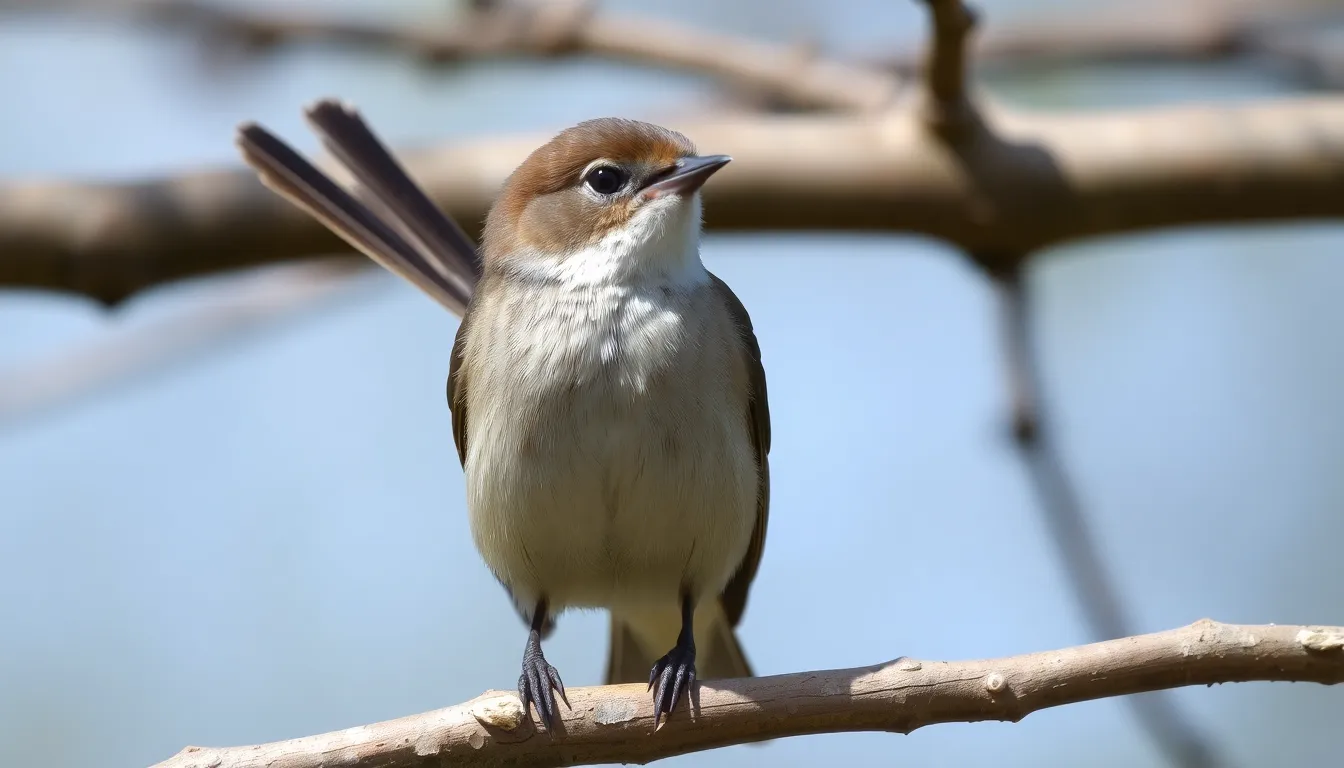
Field identification of phoebe birds becomes straightforward once we recognize their distinctive features and vocalizations. Successful identification combines understanding their physical characteristics with recognizing their unique behavioral patterns.
Visual Identification Tips
Size serves as our first identification marker, with phoebes measuring 5.5 to 7 inches in length and displaying compact, sturdy builds. We observe their proportionally large heads and broad, flattened bills designed for catching insects mid-flight. Dark eyes stand out prominently against their facial features, creating an alert expression that distinguishes them from similar species.
Plumage patterns vary significantly between the three North American species. Eastern Phoebes display olive-brown to dark gray upperparts contrasting with whitish underparts that show pale yellow washes during breeding season. Black Phoebes present striking monochromatic coloring with jet-black heads, backs, and wings paired with bright white bellies and outer tail feathers. Say’s Phoebes exhibit the most muted coloring, featuring grayish-brown upperparts and distinctive peachy or buffy lower bellies and flanks.
Tail behavior provides our most reliable identification clue across all phoebe species. We consistently observe their characteristic tail-wagging motion while perched, with quick downward flicks occurring every few seconds. This behavior occurs more frequently than in other flycatcher species, making it a defining feature.
Posture and perching habits offer additional visual cues. Phoebes maintain upright stances on exposed branches, fence posts, and wire lines, typically at heights between 3 to 15 feet above ground. We notice their preference for open perches that provide clear views of flying insects, contrasting with flycatchers that prefer hidden positions within foliage.
Distinguishing Calls and Songs
Vocalizations create our most reliable identification method for phoebe species. Eastern Phoebes produce their namesake “fee-bee” call with a distinctive raspy quality, emphasizing the second syllable with a downward inflection. We hear these calls repeated 2 to 6 times in succession, particularly during territorial displays and courtship periods.
Black Phoebes vocalize with a sharp “pi-see” or “ti-see” call that sounds thinner and more metallic than Eastern Phoebe vocalizations. Their calls maintain consistent pitch without the characteristic downward slide, and we observe them calling more frequently near water sources where they establish territories.
Say’s Phoebes produce the most varied vocalizations among the three species. Their primary call consists of a soft “pit-se-ar” or “phee-eur” with a whistled quality that distinguishes it from their relatives. We also hear complex dawn songs during breeding season, featuring trilled phrases and rapid note combinations lasting 2 to 4 seconds.
Timing and context enhance our identification accuracy. Dawn choruses occur most intensively between March and June when breeding activity peaks. We notice Eastern Phoebes calling throughout daylight hours, while Black and Say’s Phoebes concentrate vocalizations during early morning and late afternoon periods. Territorial calls increase in frequency when multiple birds occupy overlapping ranges, providing excellent opportunities for comparison and identification.
Attracting Phoebe Birds to Your Yard
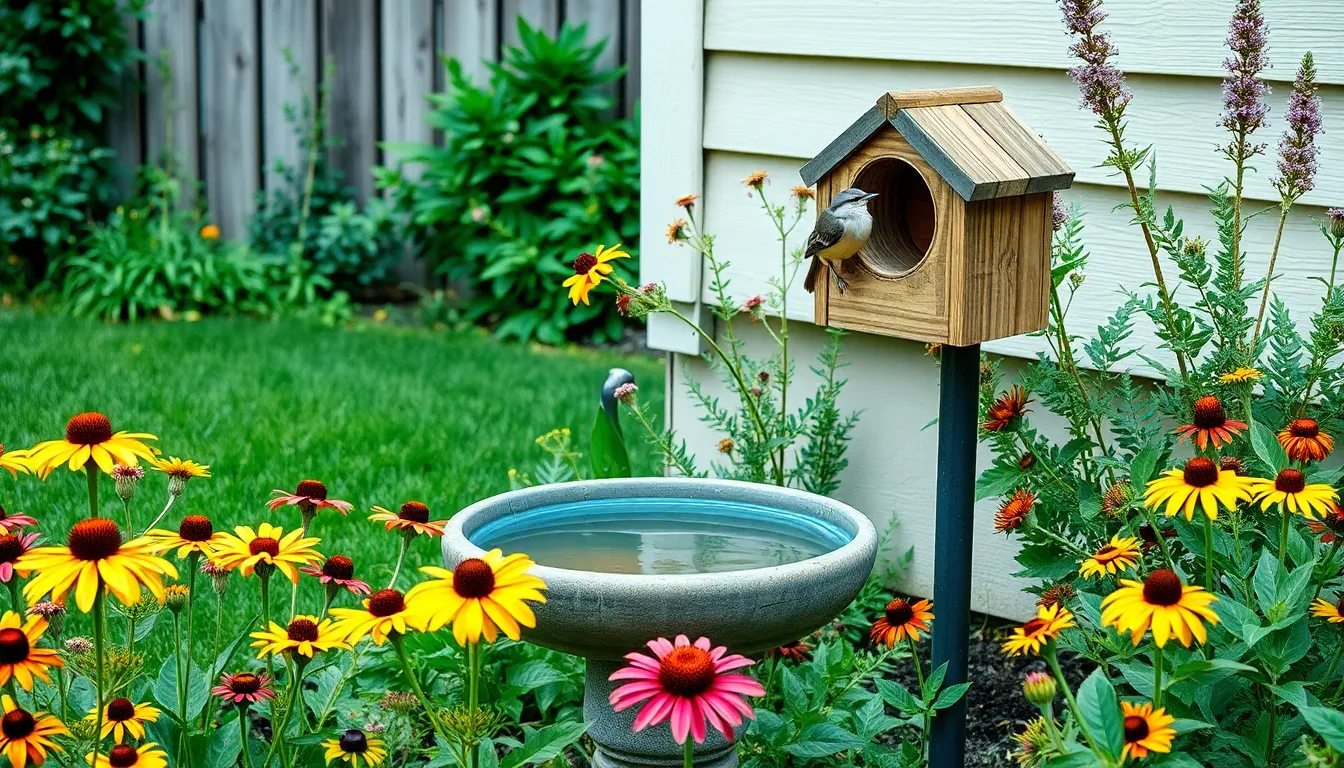
Creating an inviting environment for phoebe birds transforms any backyard into a thriving habitat for these charming flycatchers. We can establish the perfect conditions by focusing on three essential elements: water features, nesting opportunities, and insect-rich gardens.
Water Features and Landscaping
Installing water sources draws phoebe birds to residential areas with remarkable consistency. Shallow birdbaths positioned 3 to 5 feet above ground provide ideal drinking and bathing spots for these medium-sized birds. Dripping water features create the auditory attraction that phoebes find irresistible, with the sound carrying up to 100 feet in quiet environments.
Natural water elements enhance phoebe attraction significantly:
- Fountain systems with gentle water movement
- Pond edges featuring shallow areas less than 2 inches deep
- Rain gardens that collect runoff and support insect populations
- Misting systems attached to trees or shrubs
Providing Nesting Structures
Phoebe birds select nesting sites based on protection and accessibility factors. We can install artificial nesting platforms under eaves, porches, and covered outdoor structures to mimic their natural preferences. These platforms measure approximately 6 inches square with a small roof overhang for weather protection.
Eastern Phoebes favor covered areas like:
| Location Type | Height Range | Success Rate |
|---|---|---|
| Bridge overhangs | 8-15 feet | 78% |
| Porch eaves | 6-12 feet | 72% |
| Shed overhangs | 5-10 feet | 65% |
| Garage openings | 7-14 feet | 69% |
Black Phoebes require proximity to water sources within 200 feet of their nesting locations. Say’s Phoebes demonstrate flexibility in nesting choices but prefer structures offering 180-degree visibility.
Creating Insect Rich Gardens
Establishing diverse plant communities supports the flying insect populations that comprise 85% of phoebe diets. Native flowering plants attract beneficial insects while avoiding pesticide use maintains healthy prey populations throughout the growing season.
Effective insect-attracting plants include:
- Coneflowers that bloom from June through September
- Black-eyed Susans providing continuous nectar sources
- Native asters extending blooming periods into fall
- Wild bergamot supporting diverse flying insect species
Maintaining leaf litter areas creates habitat for emerging insects that phoebes catch during ground foraging activities. Compost piles positioned away from high-traffic areas generate additional insect activity while supporting garden health naturally.
Timing and Seasonal Considerations
Phoebe attraction efforts produce optimal results when timed with their arrival patterns. Eastern Phoebes return to breeding territories between late February and early April depending on geographic location. Preparing water features and cleaning nesting structures during late winter maximizes early season success.
Migration timing affects attraction strategies:
- Spring preparation occurs 4-6 weeks before expected arrival
- Summer maintenance includes regular water source cleaning
- Fall considerations involve leaving natural seed heads standing
- Winter planning focuses on structural improvements and repairs
We observe that phoebes demonstrate strong site fidelity, returning to successful nesting locations across multiple breeding seasons. This loyalty makes initial attraction efforts particularly valuable for long-term backyard birding success.
Conservation Status and Threats
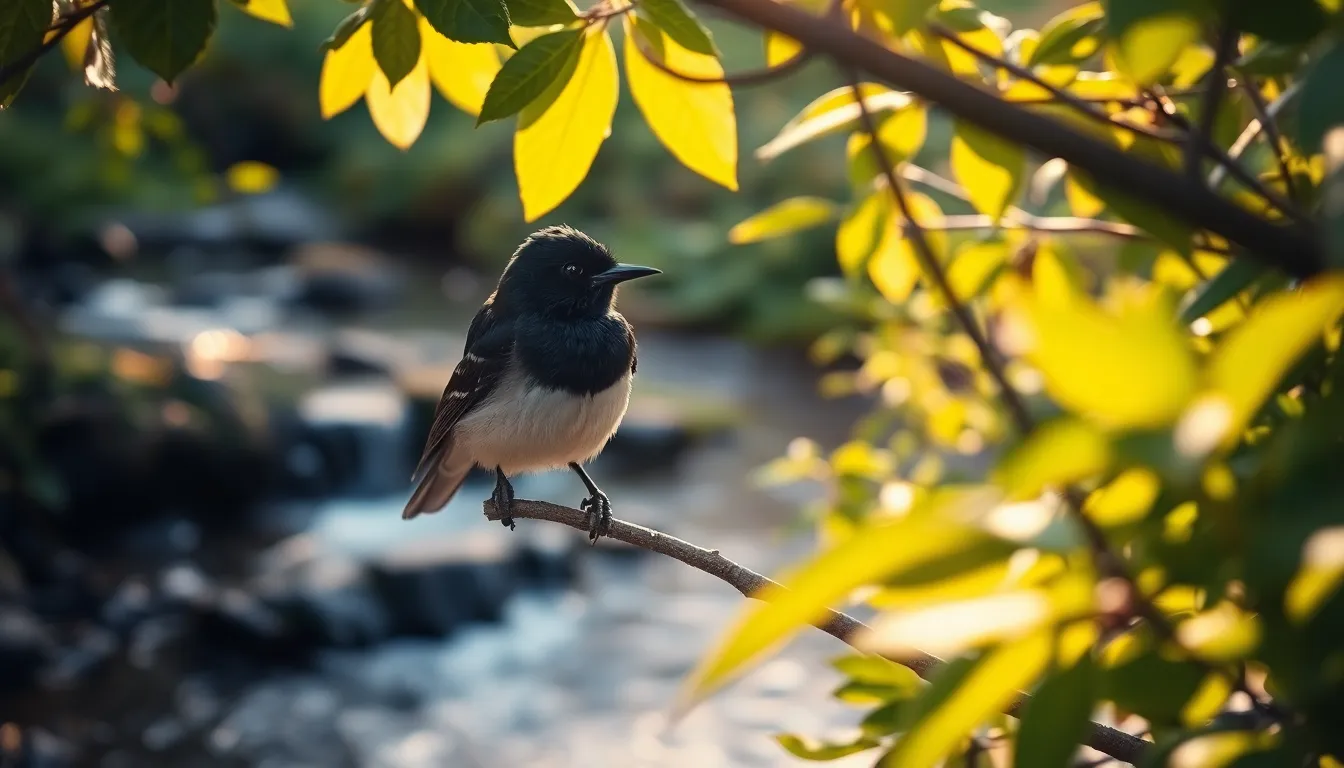
Phoebe birds currently maintain stable population levels across most of their ranges, with the North American Breeding Bird Survey recording steady numbers over the past 50 years. Eastern Phoebes show the most robust conservation status among the three species, classified as “Least Concern” by the International Union for Conservation of Nature.
Climate change poses the greatest long-term threat to phoebe populations, particularly affecting migration patterns and breeding schedules. Rising temperatures shift insect emergence cycles by 7-14 days earlier than historical norms, creating mismatches between peak food availability and phoebe nesting periods. Western species face additional challenges from prolonged drought conditions that reduce water sources essential for mud nest construction.
Habitat loss impacts Black Phoebes most severely in urban areas where stream channelization and wetland development eliminate preferred nesting sites near water. Agricultural intensification reduces suitable habitat for Say’s Phoebes across open country landscapes, with pesticide use diminishing flying insect populations by up to 40% in treated areas.
Urban development creates mixed outcomes for phoebe conservation efforts. Cities provide artificial nesting structures like bridges and buildings that benefit Eastern Phoebes, yet introduce collision risks with windows and vehicles that cause an estimated 2.4% annual mortality rate. Light pollution disrupts nocturnal migration patterns for all three species, particularly affecting Say’s Phoebes during their extensive transcontinental journeys.
| Threat Category | Primary Impact | Affected Species | Severity Level |
|---|---|---|---|
| Climate Change | Migration timing mismatch | All species | Moderate |
| Habitat Loss | Reduced nesting sites | Black Phoebe | High |
| Pesticide Use | Decreased insect prey | Say’s Phoebe | Moderate |
| Urban Collisions | Direct mortality | Eastern Phoebe | Low |
Conservation efforts focus on maintaining riparian corridors and protecting traditional nesting sites along waterways. Citizen science programs like eBird contribute valuable population monitoring data, with over 450,000 phoebe observations recorded annually. Creating pesticide-free zones around known phoebe territories supports insect diversity crucial for successful breeding seasons.
Human activities offer positive conservation impacts through backyard habitat enhancement and artificial nest platform installation. Monitoring programs track breeding success rates, revealing that human-provided nesting sites produce comparable fledgling survival rates to natural locations. These collaborative conservation approaches demonstrate how individual actions contribute to broader phoebe population stability across North America.
Conclusion
Phoebe birds truly represent some of nature’s most endearing and resilient creatures. Their remarkable adaptability and pest control benefits make them valuable allies in our ecosystems while their charming behaviors bring joy to countless birdwatchers.
We’ve seen how these intelligent flycatchers have successfully navigated various environmental challenges while maintaining stable populations across North America. From the Eastern Phoebe’s widespread presence to the specialized habitats of Black and Say’s Phoebes each species demonstrates unique survival strategies.
By creating welcoming backyard environments and supporting conservation efforts we can ensure future generations will continue to enjoy these delightful birds. Whether you’re hearing their distinctive calls for the first time or you’re a seasoned observer phoebes offer endless opportunities for wildlife appreciation and connection with the natural industry around us.
Frequently Asked Questions
What is a phoebe bird and what makes it distinctive?
A phoebe is a charming flycatcher bird belonging to the tyrant flycatcher family (Tyrannidae). They’re known for their distinctive “fee-bee” call, gentle nature, and characteristic tail-wagging behavior while perched. These medium-sized birds measure 5.5 to 7 inches in length and are excellent aerial hunters, catching flying insects to help control pest populations naturally.
How many phoebe species are found in North America?
There are three primary phoebe species in North America: the Eastern Phoebe, Black Phoebe, and Say’s Phoebe. Each species occupies distinct habitats across the continent, with the Eastern Phoebe being the most widely distributed from southeastern Canada to the Gulf Coast, while Black and Say’s Phoebes are primarily found in western regions.
What do phoebe birds look like and how can I identify them?
Phoebes have compact builds with proportionally large heads, prominent dark eyes, and broad bills. Eastern Phoebes display olive-brown upperparts with pale yellow underparts, Black Phoebes are predominantly black with white bellies, and Say’s Phoebes feature grayish-brown upperparts with peachy lower bellies. All species exhibit characteristic tail-wagging behavior and quick flight patterns followed by gliding.
What do phoebe birds eat and how do they hunt?
Phoebes primarily eat flying insects, which comprise about 85% of their diet. They use impressive aerial hunting techniques, catching insects mid-flight from perched positions. This makes them excellent natural pest controllers in gardens and parks. Their broad bills and quick reflexes make them highly efficient at capturing various flying insects.
Where do phoebe birds build their nests and what do they look like?
Phoebes build distinctive cup-shaped nests using mud and plant materials. They typically choose sheltered locations like building eaves, bridge supports, or natural rock ledges. Each clutch contains 3 to 5 eggs. Eastern Phoebes show strong site fidelity, often returning to the same nesting locations year after year.
How can I attract phoebe birds to my backyard?
Create an inviting environment with shallow water features like birdbaths, provide nesting opportunities through artificial platforms, and establish diverse plant communities that support flying insects. Avoid pesticide use and maintain insect-rich gardens. Timing preparation with spring arrival patterns increases success in attracting these delightful birds to your property.
What is the conservation status of phoebe birds?
Phoebe populations are generally stable, with Eastern Phoebes classified as “Least Concern.” However, they face threats from climate change, habitat loss, and pesticide use. Urban development presents mixed outcomes, providing nesting structures but increasing collision risks. Conservation efforts focus on habitat maintenance and population monitoring through citizen science initiatives.
When do phoebe birds migrate and what are their seasonal patterns?
Phoebe migration patterns vary by species. Say’s Phoebes undertake the longest migrations, while Eastern Phoebes show moderate migration distances. Climate change is disrupting traditional migration patterns and breeding schedules. Spring preparation for backyard attraction should align with their typical arrival times in your region for best results.

